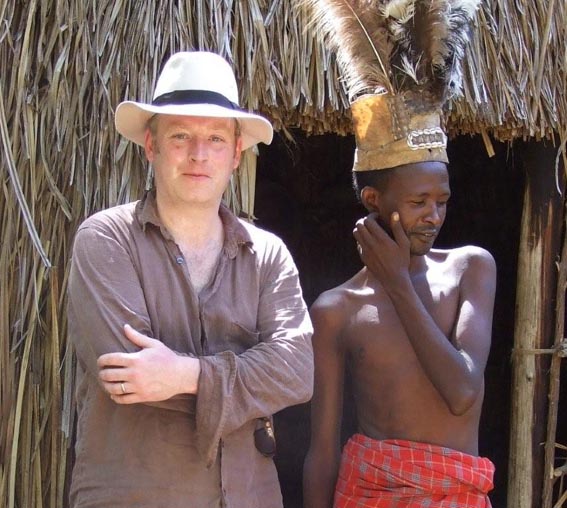|
After
leaving university Nick joined the Newcastle Evening Chronicle as a
reporter, and continued to work for local newspapers in the North-East
for several years before moving to London to work as a feature writer
for the Sunday People.
In 2000 he
became a freelance writer, contributing to national newspapers and
magazines. Shortly afterwards his first book was published: a guide to Coronation
Street.
Since
then he has written on subjects ranging from cannabis to manufactured
pop music. Nick’s last non-fiction book was a history of the
Tour de France, published in 2007.
Nick
now runs a small news and features agency in Cumbria, where he lives
with his wife, daughter and dog.
|
It’s a
sweltering day in Kenya and
I’m hanging out of the open roof of
a safari bus, camera poised, bush hat tipped at a rakish angle.
But it’s not
big game I’m after. I’m not even anywhere near the
Masai Mara. No, my target is
the headquarters of Coast Province Police, a collection of buildings
hidden
behind an imposing fence perimeter on Mama Ngina
Drive in
downtown Mombasa.
It’s here that
my fictional detective Daniel Jouma is based – and as the
site is off limits to
the public and particularly nosy English journalists, I’ve
been reduced to some
long-lensed paparazzi work.
Edward Bejah,
my normally amiable African driver, is in a state of increasing panic
because
even taking pictures of official buildings is against the law in Kenya. He
can’t understand why the hell I’m
so interested in the police headquarters anyway, or why I insisted on a
tour of
the general hospital and the Kongowea slum beforehand.
“You don’t want
to see the crocodile park?’ he asks, bemused. “The
Haller nature reserve? The
marine park at Malindi?”
Eventually I
come clean. I am not as I seem. Yes I am in Mombasa
ostensibly to write a travel piece for
a UK newspaper
– but my prime motive for being here is
to research my Kenya-based crime thrillers.
And yes, I
would like to see the croc park and the nature reserve, but only
because I plan
to use them for as set-piece scenes when kill off my baddies in cruel
and
unusual ways.
Ah, writing
fiction – don’tcha love it?
Of course there
is a serious side to all this. When you set your books 8,000 miles away
in Kenya,
there’s no point doing it all out of a
Rough Guide.
And while I
admit I am not the world’s most diligent researcher, and
while I maintain that
over-zealous swotting can clog up the narrative drive of a crime
thriller, I
nevertheless feel I owe it to the readers – and my own
credibility – to at
least make the effort to see the place for myself.
I have been to Mombasa on three
occasions in the last two
years, each time for intensive cultural immersion and specific
off-the-tourist-trail sightseeing. I have half a dozen notebooks
bulging with
observations – enough hopefully to stand me in good stead for
the four-book
series I have been contracted to complete.
Of course
setting one’s books in Kenya can be an
expensive business, and while
I would love to be able to visit every year it’s not always
possible. That’s
why I spend an inordinate amount of time in my cramped Cumbrian attic
scouring
the Kenyan online newspapers for those little snippets that bring a
country to
life.
Big news over
there currently is the ritual sacrifice of albinos, who blood is
thought to
have magical properties. Duly noted.
The badlands of
the remote Rift Valley also make for good copy. Rarely a week goes by
without
some bizarre ritualistic murder taking place. A recent example involved
a a man
lynched for digging up dead bodies and eating them, believing it would
lift a
curse on his pigs.
You don’t get
much of that in Carlisle,
I’ll tell you.
Is it all worth
it? I think so. Certainly it was extremely gratifying, following the
publication of my first novel BAIT in Africa, to
receive little or no slagging off from the
local critics about the accuracy of the setting. In fact the only
quibble was
from a reviewer in Kenya’s
Daily Nation who set about my
use of Swahili.
His name is
Stan Gazemba, and I took the liberty of contacting him – not
to administer an
Alain de Botton-style dressing down – but to ask him if he
would have a look at
the manuscript of my next book to check for similar errors.
In return I am
currently reading Stan’s novel. It’s called The
Stone Hills of Maragoli,
and despite winning the prestigious Jomo Kenyatta Prize he has found it
extremely difficult to get published in his native country.
I think it’s
great, and when he is a big name in the world of literature remember
you read
it here first.
It will be nice
to meet Stan next time I’m in Kenya
– because no matter how much research
you do, there is always more to see and people to talk to.
And that’s the
beauty of this job.

For more
information on the author, visit his
website: www.nickbrownlee.com
Burn Piatkus,
£6.99 pbk 2nd
July 2009
Read
Russell James’s review
here
|




